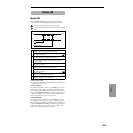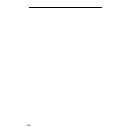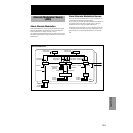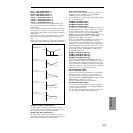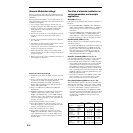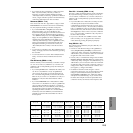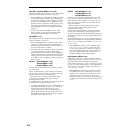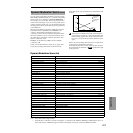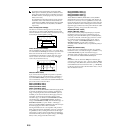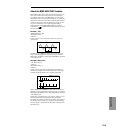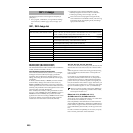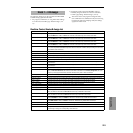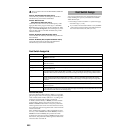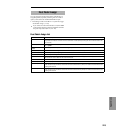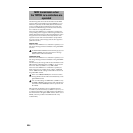
217
Appendices
You can control certain effect parameters using the joystick,
REALTIME CONTROLS knobs, etc. “on the fly.” Controlling
effects in this way is referred to as Dynamic Modulation.
For example, you can use After Touch to speed up the LFO
of the chorus and flanger, or you can use the joystick to acti-
vate the wah effect. In this way, you will be able to take full
advantage of the effects as part of the expressive potential of
your TRITON Le.
Most of the parameters for dynamic modulation consist of
parameter values for “(Source)” and “(Amount).” The
“(Source)” field selects the modulation source, and
“(Amount)” sets the amount of dynamic modulation effect.
When the modulation source is set to the maximum value,
the actual degree of the effect will be the parameter value
plus the “(Amount)” value.
Example: “W/D (Wet/Dry)” 10:90, “(Source)” AfterT,
“(Amount)” +50
In this case, the effect balance is 10:90. As you apply After
Touch, the percentage of the effect sound will increase.
When After Touch is at its maximum, the effect balance will
be 60:40.
The dynamic modulation effect will not be affected if
you modify the “(Amount)” value while dynamic mod-
ulation is being applied. The change will become effec-
tive when you operate the dynamic modulation source
again.
Refer to the corresponding effect section for an explanation
of other dynamic modulation parameters.
In the table of parameters for each effect, dynamic modula-
tion parameters are marked by a
symbol at the right
of the parameter.
Dynamic Modulation Source List
CC#: This is the control change number.
*: This indicates a controller or a function assigned to a controller on the TRITON/TRITONpro/TRITONproX. The con-
troller and the type of MIDI messages it transmits will depend on the type of connected MIDI instrument.
Dynamic Modulation Source (Dmod)
Wet / Dry
Max
Zero Higher
D
-mod
Dry
Wet
60:40
10:90
Dynamic Modulation (Example)
Wet / Dry=10:90
Amt= +50
Wet / Dry=60:40
Amt= –50
Source name Explanation
Off dynamic modulation is not used
Gate1 note on/off (☞p.218)
G1+Dmp (Gate1+Damper) note on + damper on/off (☞p.218)
Gate2 note on/off (retrigger) (☞p.218)
G2+Dmp (Gate2+Damper) note on + damper on/off (retrigger) (☞p.218)
Note No. (Note Number) note number
Vel (Velocity) Velocity
AfterT (After Touch) after touch (Channel After Touch)
JS X (Joy Stick X) joystick X (horizontal) direction
JS+Y#1 (Joy Stick +Y: CC#01) joystick +Y (away) direction (CC#01)
JS-Y#2 (Joy Stick -Y: CC#02) joystick –Y (toward yourself) direction (CC#02)
Pdl#4 (Foot Pedal: CC#04) assignable foot pedal (CC#04) (☞p.218)
FX1#12 (FX Control1: CC#12) MIDI effect control 1(CC#12)
FX2#13 (FX Control2: CC#13) MIDI effect control 2(CC#13)
Rbn#16 (Ribbon: CC#16) MIDI CC#16: controller (ribbon controller*)
Sld#18 (Value Slider: CC#18) MIDI CC#18: Controller (Value Slider*)
Kb1#17 (Knob Mod1: CC#17) realtime control knob 1 in B-mode (knob modulation 1 CC#17) (☞p.218)
Kb2#19 (Knob Mod2: CC#19) realtime control knob 2 in B-mode (knob modulation 2 CC#19) (☞p.218)
Kb3#20 (Knob Mod3: CC#20) realtime control knob 3 in B-mode (knob modulation 3 CC#20) (☞p.218)
Kb4#21 (Knob Mod4: CC#21) realtime control knob 4 in B-mode (knob modulation 4 CC#21) (☞p.218)
Kb1[+] (Knob Mod1: CC#17 [+]) realtime control knob 1 in B-mode [+] (☞p.218)
Kb2[+] (Knob Mod2: CC#19 [+]) realtime control knob 2 in B-mode [+] (☞p.218)
Kb3[+] (Knob Mod3: CC#20 [+]) realtime control knob 3 in B-mode [+] (☞p.218)
Kb4[+] (Knob Mod4: CC#21 [+]) realtime control knob 4 in B-mode [+] (☞p.218)
Dmp#64 (Damper: CC#64) damper pedal (CC#64)
Prt#65 (Portamento Switch: CC#65) portamento switch (CC#65)
Sos#66 (Sosutenuto: CC#66) sostenuto pedal (CC#66)
SW1#80 (SW1 Mod.: CC#80) assignable panel switch 1 (SW1 modulation CC#80) (☞p.218)
SW2#81 (SW2 Mod.: CC#81) assignable panel switch 2 (SW2 modulation CC#81) (☞p.218)
FSW#82 (Foot Switch: CC#82) assignable foot switch (CC#82)
CC#83 MIDI Control Change (CC#83)
Tempo tempo (internal clock or external MIDI clock tempo data) (☞p.218)



